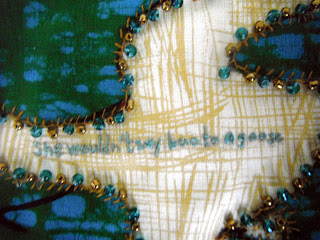When I tell people that I'm making a soft sculpture book, that is often their first question.
I am not making a baby book; I am making a book which explores the softness of women. A book composed of layers (tissues, fabric?) of women's history, women from my family, women to whom the handkerchiefs concealed in the pockets of the book belonged.
On Being Soft is a
patchwork book on two levels; a book patched together out of fragments of fabric, and of fragments
of text; of overhead conversations and asides, text messages, private thoughts.
Of scraps.
The book artist and critic Johanna Drucker wrote in her essay Intimate Authority: Women, Books, and the Public-Private Paradox that “It is not by accident that we see so many materials in their (women’s) (book)works: doilies, pieces of silk, fragments of kimonos, clothing scraps, soap, photographs, small scrolls, jars and other containers, reused stamps, buttons, ribbons, snippets of this and that.”
One female artist who constructed a number of soft books from a life's stash of "snippets of this and that" was Louise Bourgeois. Two, Ode à l’Oubli and Ode à la Bièvre, made in 2002 when Bourgeois was ninety, are constructed from linens she collected over the course of her life, including, Ann Coxon tells us in her book Louise Bourgeois, "the set of monogrammed napkins from her bridal trousseau that serve as the backing for many of the pages". I sewed on linens of a similar age as these linens in my Cure for Love project, although they were not mine but my great-grandmother's; I haven't lived a lifetime in which to hoard beautiful fabrics rich with memories yet!
Speaking of memory, Ode à l’Oubli translates roughly as "Ode to Forgetfulness"; it is the product of a long, rich life. I wonder if the phrase "I had a flashback of something that never existed", printed in red ink on one of the fabric pages of the book, is a wry reference to senility? Certainly Bourgeois' mind was sharp until the very end; she produced art right up until the week before her death.
The only other text which appears in the book is also printed in red ink on old linen (red was a very significant colour for Bourgeois; she wrote that it was both the colour of blood and the colour of paint). It reads "The return of the repressed". Ode à l’Oubli is a book about repressed memories which rise unbidden to the surface; Coxon writes that its pages "tell a story perhaps only truly readable to the artist herself".
The pages of the book are buttoned into the binding so that they may be taken out and displayed on a wall. The pages of my book will also be removable and rearrangeable; each will have a pair of button-holes and will be tied into the cover with ribbon.
There is currently a Louise Bourgeois exhibition at the Freud Museum which borrows its title, The Return of the Repressed, from Ode à l’Oubli. I will be visiting the Museum soon to see some of Bourgeois' textile textual art in person.













































